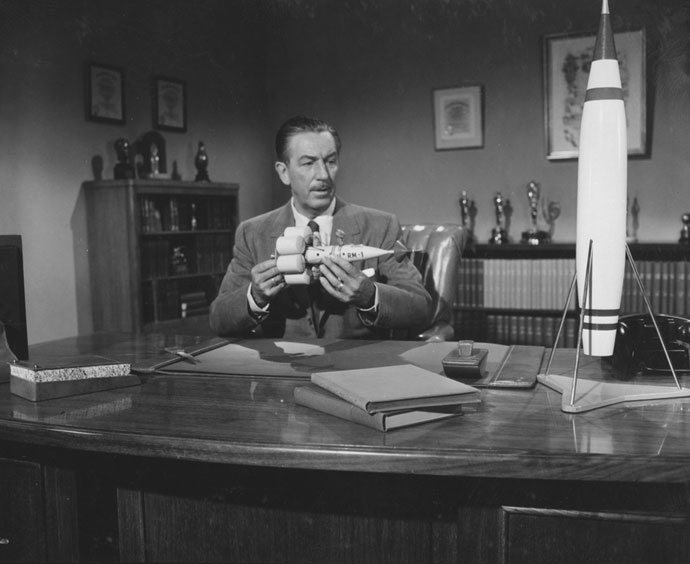14 Lessons Every Entrepreneur Can Learn From Walt Disney

Image via Disney
There are few better examples of successful entrepreneurship than Walt Disney, who began his career as a lowly animator with hardly any money but later became a business mogul, animation pioneer and beloved symbol of the magic of childhood. The Disney brand has been a juggernaut for decades, and will most likely remain so for decades to come.
Anyone looking to start their own business can learn a lot from Disney, who had his share of failures and learned quite a few lessons on the road to success. These nuggets of wisdom might not help make you into the next Walt Disney, but they certainly can’t hurt.
1. Stay in Control
Disney’s first commercially successful creation was called Oswald the Lucky Rabbit, according to Entrepreneur, but you’ve probably never heard of it because it was stolen from him. Disney had allowed Oswald to be copyrighted under his distributor’s name, not his, reports the magazine; after this devastating blow, Disney made sure he was always in control of the things he created. His next character, Steamboat Willie/Mickey Mouse, became a huge hit and a valuable property for Disney.
2. Look for Inspiration in Unexpected Places
When Disney was penniless and living out of his office in Kansas City, Mo., while working for an animated advertising company, he encountered a lot of mice, says Entrepreneur. He got the idea for Steamboat Willie from the mice that used to gather in his trashcan; one of them was his “particular friend.” Disney used a seemingly hopeless time in his life for inspiration and went on to wild success with Steamboat Willie, proving that good ideas can be found even in the trash.
3. Embrace New Technology
The 1920s and ’30s were a much more low-tech age, but they were also a time of innovations: New inventions like Technicolor and sound were seen as daring risks for filmmakers. Actors, directors and even some audiences vehemently disliked talking pictures. However, as Wesley Stout of the Saturday Evening Post predicted, people eventually adapted their ears — and their eyes — and Disney cashed in. He also created the first full-length animated movie (“Snow White and the Seven Dwarfs”), and, according to Entrepreneur, was the first Hollywood studio head to get on board with television, which turned out to be quite lucrative, as the famous “Mickey Mouse Club” enthralled kids everywhere while providing advertising for the Disney brand.
4. Give People What They Want — And What They Need
Disney’s studio was a success even during the Great Depression — in fact, by 1939, the studio actually needed a larger facility, according to the State Historical Society of Missouri. This wasn’t just because people wanted to see movies, but because they needed an escape from the crushing poverty and hopelessness of the times.
5. Be a Pioneer
Disney wasn’t just a pioneer in animation; he was also quite savvy in terms of marketing and branding. According to Entrepreneur, “Snow White and the Seven Dwarfs” was the first film ever to already have a complete merchandising campaign in place when it was released; the movie earned almost $1.5 million, and this was during the Great Depression. The Disney brand has only expanded exponentially from there.
6. Respect Everyone
Despite his successes, Disney made mistakes. One of the most notorious of these was the 1946 live action/animation “Song of the South.” Vilified by critics on Rotten Tomatoes and widely recognized as a racist whitewashing of the post-slavery American South, this film was a commercial disappointment that hasn’t been let out of the Disney vault in over 25 years, according to Slate.
7. Hire People More Talented Than You
According to Lifehack, Disney said that he was a “terrible” animator, so he did his best to hire extremely talented people that he knew could create what he visualized. Disney was said to be a hard taskmaster, and expected nothing less than the best from his employees.
8. Improve On What You Have
“Disneyland will never be completed. It will continue to grow as long as there is imagination left in the world,” Disney once said. He was also an obsessive tinkerer, says Lifehack. After moving on from animated shorts to films like the innovative “Snow White and the Seven Dwarfs,” “Cinderella” and “Alice in Wonderland,” he moved onto something new with Disneyland, at which he personally tested all the rides, always on the lookout for ways they could be improved.
9. Build an Empire
After Disneyland came Disney World, and with those ventures came several Disney-centric TV shows used to promote the theme parks. Shows like “Walt Disney’s Wonderful World of Color,” originally called “Disneyland,” made kids fall in love with the Disney brand and demand trips to Disneyland — and the only reason they were put on the air was because Disney had made a deal with television studios in which they financed Disneyland in exchange for original Disney programming. One thing built upon another, and the Disney empire began to grow.
10. Follow Your Vision
From a very young age, Disney loved drawing. He spent hours sketching, doodling and selling drawings to neighbors; he continued this love for art as an adult, and made it his career. He later said that Disneyland was a work of love.
11. Don’t Listen to Naysayers
Not only was Disney told that no one would sit through an entire animated feature film, says Lifehack, he was also told that living actors couldn’t be mixed with animated characters, that a mouse character would frighten women and that a theme park would be a huge failure. Imagine what might have happened if Disney had actually listened to everyone who told him that his ideas would never work.
12. Learn To Handle Failure
Laugh-O-Grams, Disney’s first animation studio, never made any money; after existing for just one year, it went bankrupt in 1923. The character Disney had created there, Oswald the Lucky Rabbit, also didn’t make him any money thanks to the copyright being stolen from him. But Disney rallied, and came back with Steamboat Willie soon after. Even when he became more successful, however, he was still denied financing for Disneyland over 300 times before making a deal with television studios.
13. Be Unique
“I am not influenced by the techniques or fashions of any other motion picture company,” said Disney, according to Forbes, which points out that no one gets called an innovator for copying the ideas of others.
14. Put On a Show
If there’s one thing that’s for certain about Walt Disney, it’s that he was a showman. To inspire his animators, he would often act out scenes for them, according to Lifehack, even doing their voices. When he ran out of money halfway through making “Snow White and the Seven Dwarfs,” he visited producers in person and showed them the existing footage, finally convincing them to finance the rest of the film. He captivated thousands of visitors with the spectacle of Disneyland. Today, the Walt Disney corporation is worth almost $157 billion. To be a success, you have to impress people by putting on a show that they’ll never forget; Disney certainly did.









































